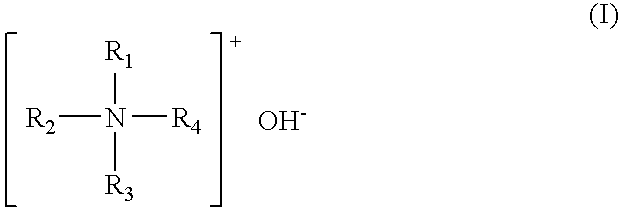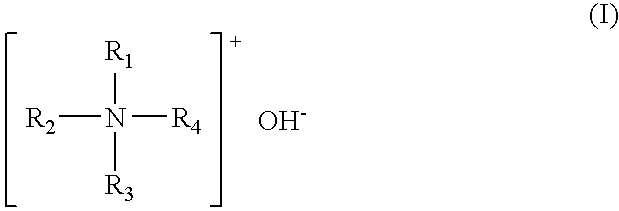Photoresist stripping solution
a technology of photoresist and solution, applied in the direction of inorganic non-surface active detergent compositions, detergent compositions, chemistry apparatus and processes, etc., can solve the problems of inconvenient peeling, acrylic film may lose its transparency, negative photoresist pattern (photocured pattern) is more difficult to remove, etc., to increase the solubility and increase the solubility
- Summary
- Abstract
- Description
- Claims
- Application Information
AI Technical Summary
Benefits of technology
Problems solved by technology
Method used
Image
Examples
examples
[0056] The invention is described in more detail with reference to the following Examples, to which, however, the invention should not be limited.
examples 1 to 5
Comparative Examples 1 to 4
[0057] Stripping solutions each having the composition shown in Table 1 below were prepared. These were tested in the following test methods for their photoresist strippability and for their side effects of damaging (swelling / coloring) acrylic transparent films and eroding metal wiring (Al-based wiring) materials. The results are given in Table 2.
[Photoresist Strippability]
[0058] A positive photoresist, TFR-1070 (by Tokyo Ohka Kogyo Co., Ltd.) comprising a naphthoquinonediazide compound and a novolak resin is applied onto a silicon substrate, using a spinner, and pre-baked at 110° C. for 90 seconds to form thereon a photoresist layer having a thickness of 1.5 μm. Through a mask pattern, the photoresist layer is exposed to light, using an exposing device NSR-1505G7E (by Nikon Corp.), and then developed with an aqueous 2.38 mas. % tetramethylammonium hydroxide (TMAH) solution to form a photoresist pattern. Next, this is post-baked at 140° C. for 90 second...
examples 6-10
Comparative Examples 5-8
[0072] Stripping solutions each having the composition shown 5 in Table 3 below were prepared. These were tested in the following test methods for their photoresist strippability and for their side effects of copper dissolution and copper oxidation. The results are given in Table 4.
[Photoresist Strippability]
[0073] A photoresist dry film of negative photoresist (ORDYL, by Tokyo Ohka Kogyo Co., Ltd.) is laminated on a wafer having thereon a rerouting copper pattern formed of a sputtered copper film. Though a mask pattern, the negative photoresist dry film is selectively exposed to light, and developed with a sodium carbonate solution to give a photoresist pattern (thickness: 120 am).
[0074] Next, a copper post (height: 120 am) is formed in the area not having the photoresist pattern, by electroplating.
[0075] The thus-processed substrate is dipped in a photoresist stripping solution (at 60° C.) shown in Table 3 below for 60 minutes, and then observed with a...
PUM
| Property | Measurement | Unit |
|---|---|---|
| thick | aaaaa | aaaaa |
| height | aaaaa | aaaaa |
| thickness | aaaaa | aaaaa |
Abstract
Description
Claims
Application Information
 Login to View More
Login to View More - R&D
- Intellectual Property
- Life Sciences
- Materials
- Tech Scout
- Unparalleled Data Quality
- Higher Quality Content
- 60% Fewer Hallucinations
Browse by: Latest US Patents, China's latest patents, Technical Efficacy Thesaurus, Application Domain, Technology Topic, Popular Technical Reports.
© 2025 PatSnap. All rights reserved.Legal|Privacy policy|Modern Slavery Act Transparency Statement|Sitemap|About US| Contact US: help@patsnap.com


